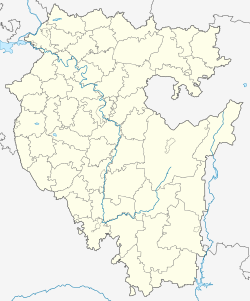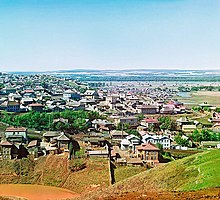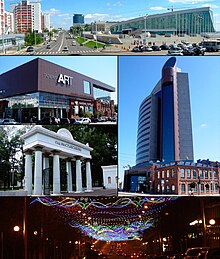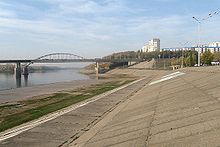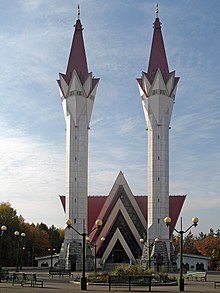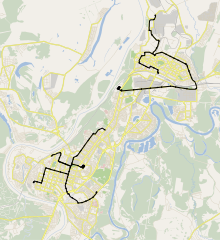Ufa (city)
city
|
||||||||||||||||||||||||||||||||||||||||
|
||||||||||||||||||||||||||||||||||||||||
|
||||||||||||||||||||||||||||||||||||||||
| List of cities in Russia | ||||||||||||||||||||||||||||||||||||||||
Ufa ( Russian Уфа́ ; Bashkir Өфө , Öfö; Tatar Уфа , Ufa ) is the capital of the Republic of Bashkortostan in Russia . The city has 1,062,319 inhabitants (as of October 14, 2010); 54.2% of them are Russians , 27% Tatars , 11.3% Bashkirs , 2.6% Ukrainians , 1.1% Chuvashes , 1% Mari and the rest belong to many other small minorities (as of 2002).
geography
The city of Ufa is located at the confluence of the Ufa and Djoma rivers with the Belaja (Agidel), about 100 kilometers west of the Urals . The city stretches about 50 km from southwest to northeast and covers an area of 753.7 km². The Ufas time zone is GMT + 0500 or CET + 0400 (Central European Time +4 hours). Summer time has not been postponed since 2011.
administration
The city of Ufa is divided into seven urban rajons (residents 2010):
- Djomski (Дёмский, 55.230)
- Kalininski (Калининский, 195.818)
- Kirovsky (Кировский, 130.880)
- Leninsky (Ленинский, 76.288)
- Oktyabrsky (Октябрьский, 229.270)
- Ordzhonikidsevsky (Орджоникидзевский, 176,877)
- Sovetsky (Советский, 166.449)
For this, the city administration are imputed rural settlements with a total population of 7,288, bringing the total population of the city circle Ufa is 1,038,100.
climate
Ufa is located in the zone of the temperate northern forest steppes. The climate is continental and humid with warm summers and moderately cold winters. The mean temperature in January is −14.6 ° C, the minimum −40 ° C; in July the mean temperature is 19.0 ° C, the maximum temperature 40 ° C. The annual average precipitation is 419 millimeters, the annual average temperature 2.5 ° C.
| Ufa | ||||||||||||||||||||||||||||||||||||||||||||||||
|---|---|---|---|---|---|---|---|---|---|---|---|---|---|---|---|---|---|---|---|---|---|---|---|---|---|---|---|---|---|---|---|---|---|---|---|---|---|---|---|---|---|---|---|---|---|---|---|---|
| Climate diagram | ||||||||||||||||||||||||||||||||||||||||||||||||
| ||||||||||||||||||||||||||||||||||||||||||||||||
|
Average monthly temperatures and rainfall for Ufa
Source: Roshydromet , wetterkontor.de
|
|||||||||||||||||||||||||||||||||||||||||||||||||||||||||||||||||||||||||||||||||||||||||||||||||||||||||||||||||||||||||||||||||||||||||||||||||||||||||||||||||||||
History and economic development
The Bashkirs settled the southern part of the Ural Mountains before the start of the Russian expansion towards Siberia . A Bashkir settlement on the site of today's metropolis probably already existed in the Middle Ages.
The real story of Ufa does not begin until a Russian fortress was built in 1574. This was intended to secure Russia's southeast border after the Bashkir territories were annexed . Historical documents show that after the subjugation of the Kazan Khanate, ambassadors on behalf of Ivan IV were sent to the area to suggest that they should join the Russian authorities. In the period from 1554 to 1557, all Bashkir tribes voluntarily joined the Russian Federation. However, since they were still plagued by raids by warlike nomads and there were no cities or military facilities in the entire area, a division of the Russian rifle corps built a small oak fortification at the mouth of the Ufa River in the Belaya near the old Kazan trade route Fortress Ufa. At that time this was the easternmost city in today's Russia - right down to the Pacific Ocean . A 440-meter-long oak wall surrounded the small fortress, hence its nickname at the time, the "oak town". The settlement was given a stone church in 1579 and in 1586 Ufa was granted city rights. The city was attacked several times by the steppe peoples living nearby, but it was successfully defended. In 1635 the city was besieged by troops of the Siberian princes Tjawka and Ablai , but they were routed . During the 17th century, Ufa remained an important fortress and trading town on the border with Siberia. At the same time, the city gradually changed from a military fortress to the political and economic center of the region in the 17th and 18th centuries. Politically, the city belonged to the Kazan government from 1708 . From 1728 Ufa was the capital of the Ufa Province, which was directly subordinate to the Senate . From 1744 the city belonged to the Orenburg governorate , which reduced the importance of Ufa as the administrative center of Bashkiria. On May 23, 1759, a fire was set off in the city by lightning, which destroyed the wooden fortress and large parts of the city. The rebuilt fortifications remained until the Pugachev uprising (1773-1775), which the city withstood for a long time. Since 1772 the town hall accommodated the city council for the self-government of the city. Eleven years later, in December 1781, Ufa became the capital of the new Ufa Province, before the Orenburg Governorate again in 1796 . Since the end of the 18th century, Ufa has been the seat of the Muslim "spiritual assembly" for the southern Urals and a mufti appointed by the tsar . Since 1802, Ufa was a provincial town with the temporary residence of the governor and his administrative institutions. In 1819 the city was extensively expanded. Relatively wide streets and open spaces were being created. In 1865, by decree of Tsar Alexander II , Ufa was made the capital of the Ufa governorate with six counties. The town for soldiers and civil servants, which was also an important traffic junction, now developed into an industrial center. By the middle of the 19th century there were already around a dozen tanneries and a few piers on the river. The introduction of regular shipping was important for the further development. After the Belaja River was made navigable (1857/58), connections to Kazan and Nizhny Novgorod were established from 1870 onwards . Ufa became the largest port in the Urals region. From 1885 it was connected to the network of the Russian railways, the main workshops and depots of which were built in Ufa. This was followed by the opening of the Kazan-Zlatouster Railway from 1888 to 1892. Steam mills, sawmills, railway and ship repair workshops were built in the town. At the end of the 19th century there were around 30 factories in Ufa: food, leather, silicate and wood processing companies. In addition, Ufa became an important place in the meat and pasta trade.
In 1917/18 Ufa was briefly the seat of a Muslim national assembly and, in September 1918, a provisional government that demanded authority for the whole of Russia and constituted itself against the Bolsheviks . Despite repeated advances by the Red Army , Ufa remained under the influence of various white groups and the Bashkir national movement until the end of 1919.
Ufa was also the capital of the Bashkir Autonomous Soviet Socialist Republic BASSR (since 1922). In the following years, as part of the first five-year plan, an engine factory and the first TEZ (remote power station) were built, and in 1939 the first oil processing company Ufa was opened. The city continued to develop in the 1920s and 1930s. Industrial production increased 16-fold during this period. The Ufa industrial combine, consisting of a match and a lightbulb factory, a sawmill and a large tannery, was built. There were also other companies in the food and light industry. During the Second World War , around a dozen large industrial companies, many authorities and a number of scientific institutes were evacuated to Ufa, including the Communist International (Comintern) by order of Stalin . In Ufa there was a prisoner of war camp 319 for German prisoners of war of World War II.
In the post-war period, the exploitation and processing of the Bashkir oil deposits played the largest role in the Ufa economy. The "Neu-Ufaer Ölverarbeitung" was opened in the 1950s. The third oil processing company soon followed. In addition, the chemical and mechanical engineering industries also gained a foothold in the city. By resolution of the Soviet of the BASSR, the city of Chernikovsk in the north of Ufa was incorporated into the city of Ufa on July 24, 1956 as Ordzhonikidze district.
Ufa has been the capital of the then established Republic of Bashkortostan since 1991 . The city gained international fame when a Bashkirian Airlines Tupolev Tu-154 and a Boeing 757 collided over Lake Constance near Überlingen on July 1, 2002, when passengers from Ufa, including 49 children and young people, died.
In 2015, a triple summit of the BRICS countries, the Eurasian Union and the Shanghai Cooperation Organization took place in Ufa .
Population development
| year | Residents |
|---|---|
| 1897 | 49,275 |
| 1939 | 250.011 |
| 1959 | 546.878 |
| 1970 | 770.905 |
| 1979 | 969.289 |
| 1989 | 1,082,052 |
| 2002 | 1,042,437 |
| 2010 | 1,062,319 |
Note: census data
The Bashkirs , titular nation of the Autonomous Republic of Bashkortostan, are only the third largest ethnic group in the city after the Russians and Tatars . Nevertheless, all public facilities, streets and many shops are signposted in both languages.
religion
The predominant religions are Christianity in the form of the Russian Orthodox Church , as well as Islam . The headquarters of the Central Spiritual Administration of Muslims in Russia , under Grand Mufti Talgat Tajuddin since 1980, is located in Ufa .
Culture and sights
There are many cultural institutions in Ufa. Sights are:
- Salawat Yulayev's monument over the Belaya, built in 1968 and renovated in 2004
- the shopping mall "Gostiny Dvor" in the city center
- the newly built mosque "Ljalja-Tjulpan" in the north of the city
- the "Monument Druzhby" (Monument of Friendship between Bashkirs and Russians), built in 1965
- the Bashkir State Theater
- the Palace of Culture
- Lenin Square at the “Gorsovjet” (City Council) with an adjoining park and entertainment center
- the Yakutov Park
- the Aksakov Park
- the memorial for the end of 1936 there murdered 187 Catholics at the largest cemetery
education
Ufa is a university town and there are also universities.
Further educational institutions in Ufa are:
- Bashkir Academy of State Service and Administration under the President of the Republic of Bashkiria
- Bashkir State Agrarian University
- Bashkir State Medical University
- Bashkir State University
- Bashkir State Pedagogical University
- Faculty of the All-Russian Distance Institute of Finance and Economics
- Ufa Faculty of the Urals State Academy of Sports
- Branch of the Moscow State Trade University
- Branch of the Orenburg State University
- Branch of the Metropolitan Humanities Institute
- Ufa branch of Moscow University of Consumer Cooperation
- Legal Institute of the Ministry of Interior of Russia Ufa
- Eastern Institute for Economics, Humanities, Business Administration and Law
- Ufa State Technical Petroleum University
- Ufa State Technical Aviation University
- State Art Institute Ufa
- Technological Service Institute Ufa of the State Academy for Consumption and Services
- Ufa branch of Moscow University of Finance
Sports
Ufa is represented by the Salawat Julajew ice hockey team in the Continental Hockey League (KHL) . The team’s greatest success is the 2010/2011 championship . The home games are played in the Ufa-Arena , which was completed in 2007 and has a capacity of 8,500 spectators for ice hockey games. The arena was the venue for the two opening games for the 2007 Super Series and, next to the Salawat Julajew Sports Palace, it was the venue for the 2013 U20 Junior Ice Hockey World Championship . The KHL All-Star Game 2017 was also hosted here. In Ms. Hockey Ufa is by Agidel represented.
In football , Ufa was represented during the Soviet era by the club FK Gastello Ufa in the third Russian league (it was and is also a professional league). In the 1990s, Ufas professional football disappeared into oblivion. A few years ago, however, the club Neftjanik Ufa managed to rise to the third Russian division. In the Ural-Volga zone, the team belonged to the upper third. The venue was the Stroitel Stadium with a capacity of 10,000 spectators (all seats). In 2010 the new club FK Ufa was founded, which has meanwhile risen to the Premjer league .
The volleyball men's by Ural Ufa playing in the Russian Super League.
Ufa hosted the 2009 European Biathlon Championships and the 2006 and 2012 Summer Biathlon World Championships .
The finals for the ice speedway world championship also took place in the Ufa ice rink .
Economy and Infrastructure
Industrially, Ufa is shaped by the oil industry ( Bashneft , Ufaneftekhim ).
Transport hub
Ufa is a junction of important transport routes: the original route of the Trans-Siberian Railway runs through Ufa; In addition, it is of great importance on the road (highways), on the rivers (cargo shipping), in air transport ( Ufa international airport in the south of the city) and through pipelines for gas and oil. Motorways lead from here in the direction of Kazan, Samara, Chelyabinsk, Orenburg ( R240 ). From the south and north central bus station there are also regular bus connections to the regional centers of Bashkiria and the closer federation centers. The airport was opened in 1938 and, in addition to domestic Russian flights, is also the starting point and destination of international routes to, among others, Istanbul , Baku and Sharjah .
city traffic
City traffic runs mainly in a north-south direction from the city center in the southwest to the Chernikovka district (Ordzhonikidze district), which was added in the 20th century and which previously formed the independent city of Chernikovsk . There have been trams in Ufa since 1937. The route network is not continuous, it consists of two parts: one in the center and one in Chernikovka. The track width is 1524 mm. To relieve the roads, an expressway was built in the 1980s parallel to the Ufas traffic axis, the Oktober prospectus ( prospectus Oktjabrja ). The construction of a subway in Ufa has been discussed since the 1960s. After partial construction of the Ufa metro , construction work was temporarily suspended in 2005 due to insufficient and unclear financing.
Town twinning
In 1997, the city of Ufa renewed a city partnership with Halle (Saale) in Saxony-Anhalt . A partnership between the Bashkir ASSR and the Halle district existed before 1990. As a sign of solidarity, a copy of Ufa’s Lenin memorial stood on the Gotthard pond in Merseburg from 1971 , but was removed again in 1991. For many years there has also been a lively exchange in the field of youth and social work between Ufa and the German city of Oberhausen .
There are also city partnerships with the Turkish capital Ankara , Las Piñas in the Philippines , the Russian city of Orenburg and the Estonian city of Paldiski .
sons and daughters of the town
The sons and daughters of the city of Ufa include: a. the writers Sergei Aksakow (1791-1859) and Sergei Dowlatow (1941-1990), the world-famous dancer Rudolf Nureyev (1938-1993), violinist Vladimir Spiwakow (* 1944), the Deputy Prime Minister of the Republic of Tatarstan Silja Walejewa (* 1952), Boxer and European champion 1975 and 1977 Valery Limasov (* 1955), freediver and world record holder Natalja Moltschanowa (1962-2015), head of the Central Bank of Russia Elwira Nabiullina (* 1963), tennis player Andrei Cherkassov (* 1970), singer Semfira (* 1976) and Formula 1 racing driver Daniil Kwjat (* 1994).
See also
Individual evidence
- ↑ a b Itogi Vserossijskoj perepisi naselenija 2010 goda. Tom 1. Čislennostʹ i razmeščenie naselenija (Results of the All-Russian Census 2010. Volume 1. Number and distribution of the population). Tables 5 , pp. 12-209; 11 , pp. 312–979 (download from the website of the Federal Service for State Statistics of the Russian Federation)
- ^ A b c Joe Crescente: Ufa: Multicultural in Bashkir. International summits are intended to make the city better known and stimulate tourism. In: Russia Beyond the Headlines (German edition) of June 3, 2015, p. 12.
- ↑ Erich Maschke (Hrsg.): On the history of the German prisoners of war of the Second World War. Gieseking, Bielefeld 1962–1977.
- ↑ Das Wort zum Tag (announcement broadcast) ( page no longer available , search in web archives ) Info: The link was automatically marked as defective. Please check the link according to the instructions and then remove this notice. MDR, January 17, 2009
- ↑ Lenindenkmal Merseburg at kunst-am-wege.de
Web links
- Official website of Ufa City District (Russian, Bashkir, English)



